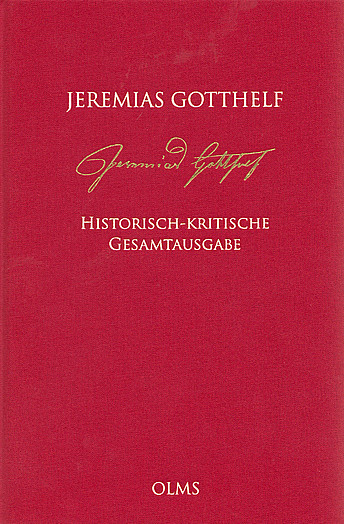Mahlmann-Bauer | Zimmermann
Jeremias Gotthelf: Historisch-kritische Gesamtausgabe (HKG)
ISBN 978-3-487-16023-8
englischThe 1830s were a time of social crisis in the Emmental region of Bern. The vast majority of rural servants and day labourers lived in grinding poverty. Gotthelf took up this 'Armennoth' in his socio-political writing of the same name from 1840. In it, he propagates the Christian doctrine of the home as a means of combating poverty: the rural landlord should act like a father towards his servants and guide them to later independence; the servants, for their part, should serve obediently and faithfully. The novel 'Wie Uli, der Knecht, glücklich wird' (How Uli the Servant Becomes Happy), published in 1841 in Zurich and Frauenfeld by Christian Beyel, uses the protagonist as an example of the education outlined in 'Armennoth': Under the guidance of his extremely pious master, the orphan Uli succeeds in an unprecedented social rise from poor, indebted farmhand to tenant of one of the largest farms in the entire Bernese region. The novel combines elements of the Bildungsroman with those of the old Christian form of conversion stories. Although it certainly reveals that Uli's career is quite extraordinary, contemporary critics complained that the book made poor maids and farmhands false promises of happiness. After the very successful edition published by Julius Springer in Berlin (1846), which in contrast to the Beyel edition was divided into chapters, 'Uli' became Gotthelf's 'best-known' novel (Hanns Peter Holl). For the longest time, however, the text version of the 'Sämtliche Werke' of 1921 was authoritative for research as well as for licensed and paperback editions, although this edition offers neither the original text of the Beyel nor that of the Springer edition. Although it was based on the text published by Beyel, it adopted the chapter division from the Springer edition; in addition, orthography and punctuation were modernised and dialect spellings standardised. With the HKG edition, the first 'Uli' novel, of which no manuscript has survived, can now finally be read again in the unaltered wording of the first edition published by Beyel.
Die 1830er-Jahre waren im bernerischen Emmental eine soziale Krisenzeit. Die große Mehrheit der ländlichen Dienstboten und Tagelöhner lebte in drückender Armut. Diese 'Armennoth' griff Gotthelf in seiner gleichnamigen sozialpolitischen Schrift von 1840 auf. Er propagiert darin die christliche Lehre vom Haus als Mittel der Armutsbekämpfung: Der bäuerliche Hausherr sollte gegenüber seinen Bediensteten wie ein Vater auftreten und sie zu späterer Selbständigkeit anleiten, das Gesinde seinerseits sollte gehorsam und treu dienen. Der 1841 in Zürich und Frauenfeld im Verlag von Christian Beyel erschienene Roman 'Wie Uli, der Knecht, glücklich wird' spielt die in der 'Armennoth' skizzierte Erziehung exemplarisch am Protagonisten durch: Unter Anleitung seines überaus frommen Meisters gelingt dem Waisenkind Uli ein beispielloser sozialer Aufstieg vom armen, verschuldeten Knecht zum Pächter eines der größten Höfe im ganzen Bernerland. Der Roman vereint Elemente des Bildungsromans mit solchen der alten christlichen Form der Bekehrungsgeschichten. Obwohl er durchaus zu erkennen gibt, dass Ulis Werdegang ganz und gar außerordentlich ist, monierten zeitgenössische Kritiker, das Buch mache armen Mägden und Knechten falsche Glücksversprechen. Nach der sehr erfolgreichen Edition im Berliner Verlag von Julius Springer (1846), die im Gegensatz zur Beyel-Ausgabe eine Kapiteleinteilung aufwies, avancierte der 'Uli' zu Gotthelfs 'bekannteste[m]' Roman (Hanns Peter Holl), seinem 'klassische[n] Buch' (Walter Muschg). Die längste Zeit war sowohl für die Forschung wie auch für Lizenz- und Taschenbuchausgaben allerdings die Textfassung der 'Sämtlichen Werke' von 1921 maßgeblich, obwohl diese Ausgabe weder den Originaltext der Beyel- noch denjenigen der Springer-Ausgabe bietet. Sie beruhte zwar auf dem bei Beyel erschienenen Text, übernahm aus der Springer-Ausgabe aber die Kapiteleinteilung; außerdem wurden Orthografie und Interpunktion modernisiert und Dialektschreibweisen vereinheitlicht. Mit der HKG-Edition ist der erste 'Uli'-Roman, von dem kein Manuskript überliefert ist, nun endlich wieder im unverfälschten Wortlaut der bei Beyel erschienenen Erstausgabe lesbar.


